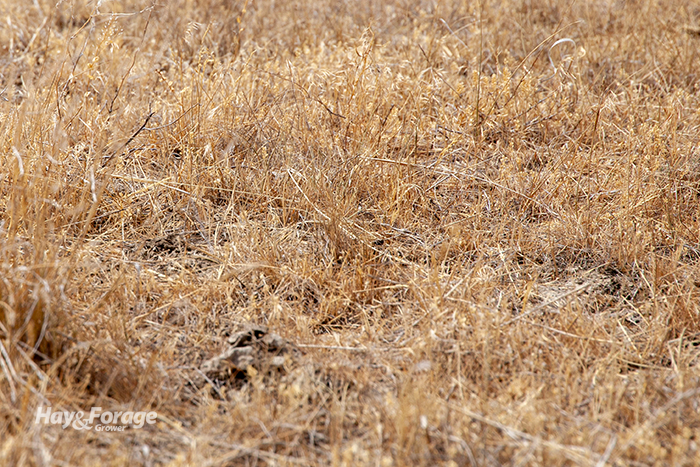
Reports of dry weather and drought conditions never seem to leave our newsfeed. Where one region receives much needed rainfall, another is slowly progressing from moderate to severe to extreme drought. In addition to the degree of dryness, the timing of drought can have significant impact on forage growth, even after the growing season ends.
Earlier this year, many conversations in Midwestern pastures and hayfields revolved around excess moisture, delayed cuttings, and wet field damage. Then, Mother Nature flipped the script and prescribed a very dry late summer and fall. In other parts of the country, drought conditions have persisted the whole time, which may leave farmers wondering how well their forage will bounce back in the spring.
Christine Gelley with Ohio State University Extension says concerns about pasture conditions cropped up in July and August as a large portion of the Buckeye State experienced extreme-level drought. The agriculture and natural resources educator assured farmers that cool-season grass pastures had entered dormancy to save energy resources during the extra dry summer slump, but now she is having second thoughts.
“Now in October and November, I am less confident that the brown and crusty grass we see is dormant,” Gelley writes in a recent article. She continues to say the plants she expected to rebound with the onset of cooler weather may actually be dead — or on their last legs.
Despite the excessive dryness, Gelley reports forage might not have walked a straight line from dormant to dead. At least in the southeast region of the state, a few scattered showers offered enough moisture to dampen the soil surface in September, yet not enough to replenish the depleted ground water reserves. Plants did green up after that bit of rain, but that may have been their final nail in the coffin.
“What I fear occurred was that those dormant forages broke their dormancy, drew from their root reserves for growth, and now those reserves are gone and the pasture is brown and crusty once more,” Gelley asserts. “If there are no more reserves left in the roots to draw from in the spring, those plants will be dead.”
In this case, she suggests farmers who are experiencing extreme drought should anticipate reseeding at least a portion of their perennial pastures and hayfields next spring. It’s likely too late to get a head start on reseeding now, and soil moisture conditions aren’t conducive for late fall forage establishment, anyway.
Steps that farmers can take to get ahead of the game include sampling soil and using those test results to create next year’s fertilizer plans. Utilizing dead spots for sacrifice lots can be an option for feeding livestock as well. And if farmers receive drought relief assistance this fall, Gelley encourages them to put the funds toward seed, fertilizer, and equipment expenses if reseeding is in fact necessary.
“A no-till drill with a fertilizer box may become your best friend come seeding time,” she states. “Think ahead about renting or buying seeding equipment well in advance so that you are ready when the conditions are right.”
No sign of seedlings
Another bright red splotch on the U.S. Drought Monitor currently stretches down the eastern edges of Montana and Wyoming and along the western North and South Dakota borders. Extension specialists with North Dakota State University report farmers there have similar concerns about dry soils, especially for new cover crop seedings that haven’t shown signs of emergence.
Some western North Dakota farmers who planted cover crops immediately after row crop harvest have yet to receive a significant shower. The stretch of no rainfall spans upward of four months farther north. At first glance, the outlook for winter annual growth isn’t bright.
“Even cover crops that were drilled or disked in and benefitted from seed-to-soil contact will have poor emergence if soil moisture is not adequate,” says cropping systems specialist Victor Gomes.
However, he adds that most types of cover crop seeds can remain dormant over the winter and make a comeback in the spring when favorable soil moisture levels and warm temperatures return. This process is called dormant seeding, which is different from frost seeding. In the case of the former practice, no fall germination is better than some.
For example, if there is enough soil moisture from a light rain to initiate seed sprouting, yet not enough to fuel further seedling growth, cover crops will not survive the winter. Dormant seeding, on the other hand, is most successful when soil moisture is insufficient for germination after cover crop seeds are drilled and incorporated into the ground before it freezes or snows. Seed activity and water uptake will be too low for any sprouting until soil temperatures are about 40ºF and soil moisture is replenished.
With that said, cover crops that were intended to germinate this fall may be pushed under the dormant seeding umbrella by default. Therefore, the specialists offer the following considerations to determine how individual stands might respond to these conditions and the impact dormant seeding may have on cover crop end use, which may include early spring grazing.
• Some cover crops are better suited for dormant seeding than others. Species like cereal rye, winter camelina, hairy vetch, triticale, and winter wheat have a better chance of surviving the winter as dormant seeds before emerging in the spring.
• Seeds should have been drilled and incorporated into the soil, not broadcasted. This ensures seeds will not be lost to rain or snow runoff during the winter and will be ready to imbibe soil moisture and germinate with warmer temperatures.
• Dormant seedings will likely require more time to grow in the spring compared to cover crops that realized some growth in the fall. Consider how this may affect spring grazing and/or planting schedules for subsequent crops and be prepared to adjust termination dates.

